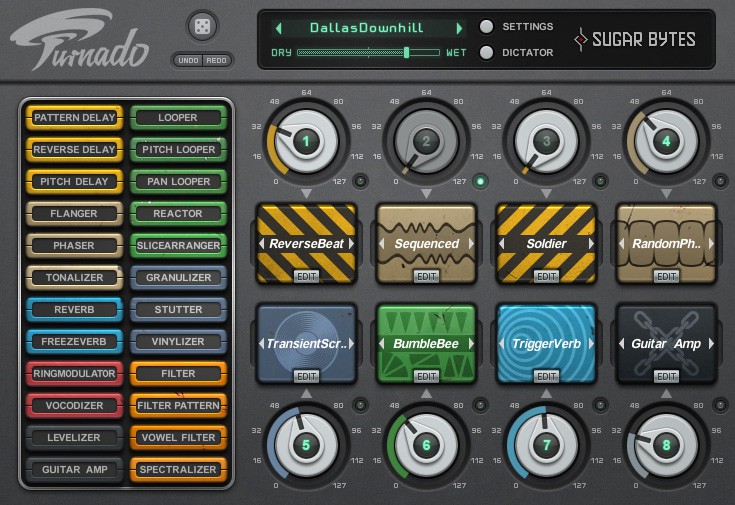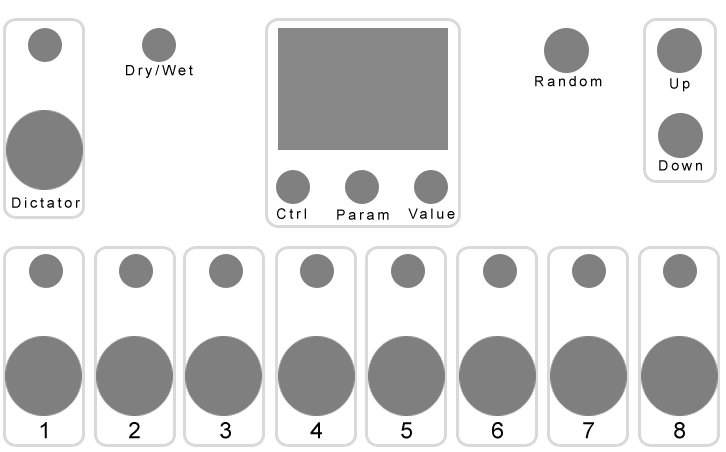What is Turnado?
Turnado is my personal favourite audio software FX plugin.
It is in my opinion the best application for real-time audio manipulation, and it is especially useful for producing glitchy/IDM style music as well as for live electronic music performance and remixing.

In a nutshell, Turnado is real-time multi effect application that has a simple interface of 8 knobs where each knob controls it's own effect in varying ways. In Dictator Mode, you can control all 8 effects simultaneously with a single fader. It contains 24 different effects - ranging from classic effects (e.g. filters, reverbs, delays) to more hi-tech effect (e.g. loopers, granular, vocoder). See below for a good features overview video.
Why Develop a Dedicated Hardware Controller?
Turnado is most useful and fun when being controlled by a hardware MIDI controller, and it is very easy to assign any MIDI controls to the 8 software knobs (as well as to many of the other plugin parameters). Being hardware controllable is essential for live performances, as in these scenarios the performer usually prefers to have direct, tangible and easy access to the software without having to mess around with computer screens, keyboards and mice. However I've found that using a generic MIDI controller to control Turnado doesn't always give the best experience or allow you to use the application to it's full potential.
Existing MIDI controllers have the following problems when being used to control Turnado:
- They don't always contain a set of controls that allow the user to control the Turnado Knobs or Dictator fader in the optimum way, both from an interactivity and musical aspect.
- They don't often contain an intuitive control layout that matches that of the software plugin, and will in most cases either not provide enough controls, or provide too many controls (where the presence of unused controls can be confusing).
- They often still rely on the user having to use the computer screen for visual feedback of the parameter values.
- They don't often make it possible or easy to allow multiple instances of Turnado (where each instance is effecting a different DAW instrument/track) to be controlled - either simultaneously or in quick succession - by a single hardware device.
This project/device aims to solve these problems in the following ways:
- Providing a set of thumb joysticks for controlling each of Turnado's knobs (and the Dictator fader) independently in an intuitive and ergonomic manner
- Providing a set of controls for controlling all of Turnado's primary parameters, no more and no less.
- Providing a control layout that roughly matches that of the software plugin, so users of Turnado will intuitively know what each set of controls do.
- Using an LCD for providing realtime visual feedback of the plugin parameters, preventing the user from needing to use the computer screen.
- Allowing each control to have an independent MIDI channel, allowing multiple instances of Turnado running on different DAW tracks to be controlled simultaneously.
- Providing a quick way to change the global MIDI channel of the device, allowing the device to quickly change which instance of Turnado it is controlling.
How Does the Hardware Controller Work?
Here is a demo video of the MIDI controller is use, controlling two instances of the Turnado plugin to perform live audio manipulation/remixing of a set of audio loops:
Here is a rough annotated 2D sketch of the controller's panel:

See the design log for more info on this, but here is a summary of the device's controls and features:
- The main section and the most novel feature of the controller comprises of 8 pairs of dedicated controls for controlling the 8 software knobs. The first control of the pair is a standard rotary encoder for setting the 'static' or 'base' value of the software knob, whereas the second control is a single axis of a thumb joystick (a self-centering continuous control) that allows 'momentary' two-way control of the parameter centring around the static / base value. Each pair of controls is grouped together on the controller's panel. The second control here is what l I find most useful for controlling Turnado, as when performing live audio manipulation it is usually done only in short bursts rather than constantly, where a control that 'springs back' is very useful. Also you are able to operate these types of controls with just one finger (compared to dials that usually need to two fingers), meaning you can operate multiple controls simultaneously. In addition, the rotary encoder includes a push switch that has two behaviours:
- When the joystick is in use (not centred) it sets the current joystick value to be the new static / base value of the software knob.
- When the joystick is not in use (centred) it resets the value of the software knob to 0.
- There is a ninth instance the previous set of controls for controlling the Dictator Mode fader in the same way.
- There is a rotary encoder for setting the global Turnado wet/dry mix parameter
- There is a pair of momentary push buttons for going up and down through Turnado presets
- There is a push button for triggering the 'randomise' parameter for quickly creating a random set of effects
- There is a button combination (randomise + preset up / down button) for changing the global MIDI channel of the device (for easily switching to control a different instance of Turnado)
- There is an LCD for displaying parameter and control values in realtime, as well as for configuring control settings such as MIDI CC number, MIDI channel etc... The LCD menu is controlled by three dedicated rotary encoders.
- Each control can have an independent MIDI channel, allowing multiple instances of Turnado running on different DAW tracks to be controlled simultaneously.
- The device will respond to MIDI-in messages from the Turnado software knobs so that the software and hardware will always be in sync. This means that if the software knob values change as a result from Dictator fader changes, from direct control on the plugin's UI or from control by the plugin host (e.g. track automation) then the hardware device will be updated with these new values so that they can be displayed on the LCD and so the joysticks and encoders will always send up-to-date values.
Open Source Licenses
The project is completely open source licensed under GPL, and uses the following open source software libraries:
- Arduino core libraries licensed under LGPL.
- Teensy core libraries licensed under GPL.
- Optimized ILI9341 TFT Library for Arduino licensed under the MIT license.
- Bounce library for Arduino licensed under the MIT license.
- Encoder library for Arduino licensed under GPL.
 Liam Lacey
Liam Lacey